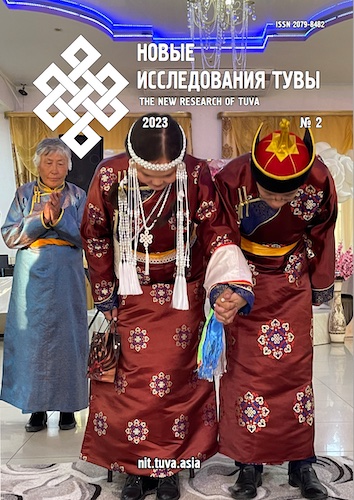Features of birth rate in the Republic of Tuva (1991–2021)
DOI:
https://doi.org/10.25178/nit.2023.2.3Keywords:
natural population growth; birth rate dynamics; total fertility rate; age-related fertility rates; marriage rates; age and gender structure of marriageAbstract
The article presents a retrospective dynamics of the total birth rate for 30 years and an analysis of changes in the rating of the Republic of Tuva on this indicator. The study allows us to formulate hypotheses of the impact of the demographic policy on the increase in natality in the region and, in particular, to consider the effect of the introduction of regional maternity capital in Tuva. The research is based on methods of generalization and synthesis, descriptive statistics techniques, in particular, for pursuing a comparative analysis of changes in the position or place of the Republic of Tuva among all Russian regions by the total fertility rate (calculation of median values, determination of quartiles in distributions, construction of a scattering diagram).
We specify an assessment of changes in the main indicators of the birth rate of the population in the Republic of Tuva and identify two periods of demographic development. The first period was between 1991 and 2006. Its distinctive characteristic is that the average annual total birth rate was 2.23 births per woman of reproductive age. In the second period (2007–2021), there was a higher average annual value of the total fertility rate. It was 3.10 births per woman of reproductive age.
Trends in age-related birth rate have shown that there is the problem of aging of fertility. This requires special attention and measures to curb the strengthening of this trend when there is a young population structure in the region. The consideration of the age-related characteristics of birth rate has revealed an increase in the modal value of age-related fertility rates amid an increase in the age of marriage among both men and women.
References
Abylkalikov, S. I. (2021) Osobennosti demograficheskogo razvitiia Tuvy: vklad migratsii v demograficheskii balans [Features of the demographic development of Tuva: Contribution of migration to the demographic balance]. New Research of Tuva, no. 4, pp. 131–142. (In Russ.). DOI: https://doi.org/10.25178/nit.2021.4.10
Abylkalikov, S. I. and Baimurzina, G. R. (2022) Osobennosti demograficheskikh protsessov v gorodakh Kyzyl i Elista v 2011–2020 gody: sravnitel’nyi analiz [Demographic processes in the towns of Kyzyl and Elista in 2011–2020: A comparative study]. New Research of Tuva, no. 2, pp. 34–52. (In Russ.). DOI: https://doi.org/10.25178/nit.2022.2.3
Aleshkovskii, I. A. (2012) Demograficheskii krizis kak ugroza natsional'noi bezopasnosti Rossii [Demographic crisis as a threat to Russia’s national security]. Vek globalizatsii, no. 2 (10), pp. 96–114. (In Russ.).
Anaiban, Z. V. (2016) Sovremennye etnodemograficheskie kharakteristiki molodezhnykh grupp Tuvy i Khakasii [Contemporary ethnodemography of youth in Tuva and Khakassia]. New Research of Tuva, no. 2, pp. 90–104. (In Russ.).
Antonov, A. I. (1999) Demograficheskoe budushchee Rossii: depopuliatsiia. Navsegda? [Demographic future of Russia: Depopulation. For evermore?]. Sotsiologicheskie issledovaniia, no. 3, pp. 80–87. (In Russ.).
Arkhangelskiy, V. N. and Zayko, E. S. (2021) Linii reproduktivnogo povedeniia [Lines of reproductive behavior]. Problemy sotsial'noi gigieny, zdravookhraneniia i istorii meditsiny, vol. 29, no. s2, pp. 1374–1380. (In Russ.). DOI: http://doi.org/10.32687/0869-866X-2021-29-s2-1374-1380
Vishnevskii, A. G. (1976) Demograficheskaia revoliutsiia [Demographic revolution]. Moscow, Statistika. 211 p. (In Russ.).
Gaifullin, A. Yu. (2022) Etnodemograficheskie kharakteristiki molodezhi v respublikakh Tyva i Bashkortostan [Ethnodemographics of youth in the republics of Tuva and Bashkortostan]. New Research of Tuva, no. 2, pp. 128–142. (In Russ.). DOI: https://doi.org/10.25178/nit.2022.2.9
Zyryanova, M. A. and Popova, M. A. (2018) Faktornyi analiz protsessov rozhdaemosti v severnykh regionakh Rossii [Factor analysis of birth rate processes in Russian northern regions]. Sever i rynok: formirovanie ekonomicheskogo poriadka, no. 3 (59), pp. 111–121. (In Russ.). DOI: https://doi.org/10.25702/KSC.2220-802X.3.2018.59.111-121
Karmanov, M. V., Kuchmaeva, O. V. and Petrjakova, O. L. (2015) Demograficheskaia bezopasnost': teoriia, metodologiia, otsenka [Demographic security: Theory, methodology, evaluation]. Statistics and Economics, no. 4, pp. 123–128. (In Russ.). DOI: https://doi.org/10.21686/2500-3925-2015-4-123-128
Mandyt, M. K. (2017) Respublika Tyva kak region ustoichivogo estestvennogo prirosta naseleniia [The Republic of Tuva as a region of sustainable natural population growth]. Uspekhi sovremennogo estestvoznaniia, no. 7, pp. 91–95. (In Russ.).
Mongush, S. P. (2021) Ekonomika narodonaseleniia i demografiia. Traditsionnoe prirodopol'zovanie v formirovanii sovremennogo prostranstvennogo razvitiia territorii (na primere Respubliki Tyva) [Population economics and demography. Traditional nature management in the formation of modern spatial development of the territory (the case of the Republic of Tuva)]. Aktual'nye voprosy sovremennoi ekonomiki, no. 11, pp. 692–705. (In Russ.). DOI: https://doi.org/10.34755/IROK.2021.40.20.054
Rostovskaya, T. K. and Kuchmaeva, O. V. (2020) Kontseptual'nye podkhody k provedeniiu Vserossiiskogo sotsiologicheskogo issledovaniia «Demograficheskoe samochuvstvie Rossii» kak instrumentu monitoringa rezul'tativnosti demograficheskoi politiki [Conceptual approaches to conducting the All-Russian sociological study “Demographic Well-being of Russia” as a tool for monitoring the effectiveness of demographic policy]. Bulletin of the South-Russian State Technical University (NPI). Series: Socio-Economic Sciences, vol. 13, no. 3, pp. 89–99. (In Russ.). DOI: https://doi.org/10.17213/2075-2067-2020-3-89-99
Rybakovskii, L. L. (2014) 20 let depopuliatsii v Rossii [20 years of depopulation in Russia]. Moscow, Institute of Socio-Political Research of the RAS. 231 p. (In Russ.).
Rybakovskii, L. L. (2015) Kontseptsiia demograficheskoi politiki Rossii: opyt razrabotki i puti sovershenstvovaniia [The concept of demographic policy of Russia: Development experience and ways of improving]. Sotsiologicheskie issledovaniia, no. 9 (377), pp. 62–70. (In Russ.).
Tinikova, E. E. (2019a) Polovozrastnaia struktura naseleniia gorodov Iuzhnoi Sibiri v seredine XX — nachale XXI v. [Gender and age structure of the population of the cities in Southern Siberia in the mid-20th — early 21st century]. Genesis: istoricheskie issledovaniia, no. 2, pp. 74–87. (In Russ.). DOI: https://doi.org/10.25136/2409-868X.2019.2.29163
Tinikova, E. E. (2019b) Brachnost' i razvodimost' naseleniia gorodov Iuzhnoi Sibiri v seredine XX — nachale XXI vv. [Marriage and divorce rates among the population of the cities in Southern Siberia in the mid-20th — early 21st century]. Genesis: istoricheskie issledovaniia, no. 9, pp. 81–92. (In Russ.). DOI: https://doi.org/10.25136/2409-868X.2019.9.30599
Filimonov, S. N., Baran, O. I. and Ryabov, V. A. (2019) Estestvennoe vosproizvodstvo naseleniia Sibirskogo federal'nogo okruga v nachale vtoroi volny depopuliatsii (osobennosti i prognoz) [Natural reproduction of the population of the Siberian Federal District at the beginning of the second wave of depopulation (peculiarities and prediction)]. Zdravookhranenie Rossiiskoi Federatsii, vol. 63, no. 3, pp. 116–121. (In Russ.). DOI: http://doi.org/10.18821/0044-197X-2019-63-3-116-121
Khol'shina, M. A. (2012) Analiz vzaimosviazei demograficheskogo i sotsial'no-ekonomicheskogo razvitiia v Respublike Tyva [Analysis of the interrelations of demographic and socio-economic development in the Republic of Tuva]. Geografiia i prirodnye resursy, no. 2, pp. 104–108. (In Russ.).
Soboleva, S. V. (2015) Demographic situation in Siberia in the context of nationwide trends. Regional Research of Russia, vol. 5, no. 2, pp. 154–162. DOI: https://doi.org/10.1134/S2079970515020100
Published
How to Cite
For citation:
Rostovskaya T. K., Zolotareva O. A. and Davletshina L. A. Osobennosti rozhdaemosti v Respublike Tyva (1991–2021) [Features of birth rate in the Republic of Tuva (1991–2021)]. New Research of Tuva, 2023, no. 2, pp. 34-49. DOI: https://doi.org/10.25178/nit.2023.2.3
Issue
Section

This work is licensed under a Creative Commons Attribution-NonCommercial 4.0 International License.

Author(s) license holder(s) grant rights for their work to the journal (grantee of a license) under the simple non-exclusive open license in accordance with Art. 1286.1 «Open license for a research work, work of literature or fine arts», Civil Code of the Russian Federation.
New Research of Tuva publishes articles under the Creative Commons Attribution-NonCommercial license (CC BY-NC).
Since it is an open license, author(s) reserve the right to upload the article to their institutional repository, submit it to another journal (if it allows republications), or republish it on their own website (in full, or in part).
However, several conditions apply here:
a) The republished version must always contain the name(s) and affiliation(s) of the author(s), the original title and the hyperlink to the original version on the New Research of Tuva website;
b) It must be in open access, free of charge, and no category of readers must be in any way whatsoever advantaged over general readership.
c) should the contribution be submitted elsewhere by its author(s) without substantial modification (30% or more of original text unchanged), the body of the article should contain a disclaimer that the original version was published in New Research of Tuva (with a link to the respective page)
The CC-BY-NC is a non-revocable license which applies worldwide and lasts for the duration of the work’s copyright.











